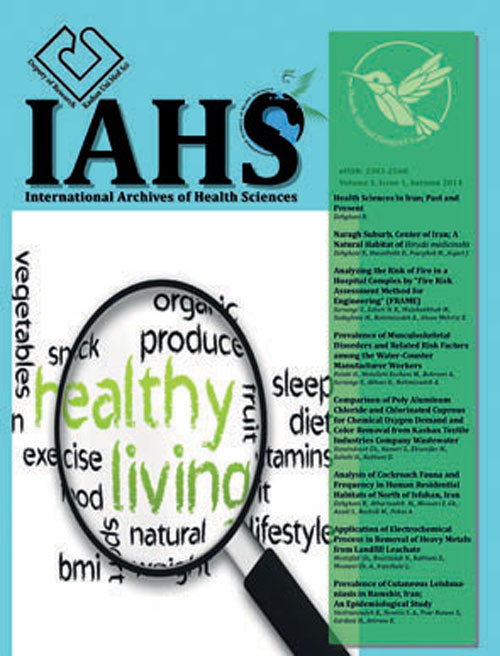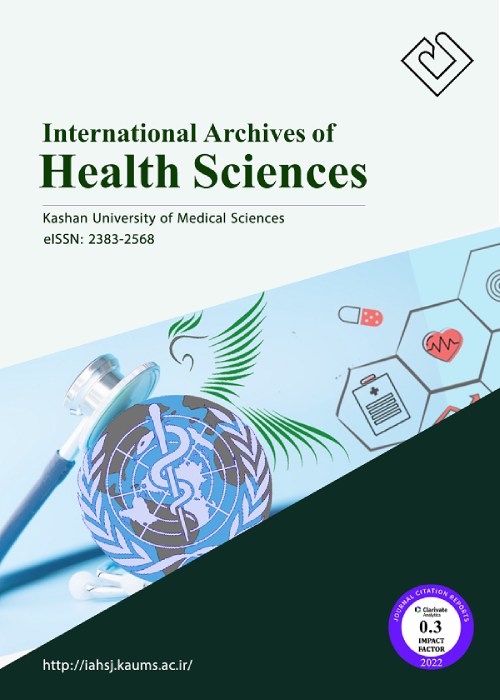فهرست مطالب

International Archives of Health Sciences
Volume:2 Issue: 1, Jan-Mar 2015
- تاریخ انتشار: 1394/04/30
- تعداد عناوین: 8
-
-
Pages 1-6AimsVenomous snake bites are public health problems in different parts of the world. The most specific mainstay in the treatment of envenomation is anti-venom. To treat the envenomation, it is very important to identify the offending species. This study was designed to determine the penetrating pattern of fangs and teeth of some viper snakes.Materials and MethodsThis descriptive study was performed on live venomous and non-venomous snakes from 2010 till 2011. All 47 sample snakes were collected from different regions of Isfahan province such as Kashan City, Ghamsar, Niasar, Mashhad Ardehal, Taher-Abad and Khozagh. Their mouths were inspected every two weeks and development of their fangs and teeth were recorded by taking clear digital photos. Fangs and teeth patterns of samples were drawn and the results were compared.FindingsOne or two wounds appeared as typical fang marks at the bite site of venomous snakes while non-venomous snakes had two carved rows of small teeth. Three different teeth and fang patterns were recognized in venomous snakes which were completely different.ConclusionThe fang marks of venomous snakes do not always have a common and classic pattern and there are at least 3 different patterns in Isfahan province, Iran.Keywords: Bites, Stings, Snake Venoms, Venoms, Viper Venoms
-
Pages 7-12AimsRegarding water as the main source of brio, not only its quantity and being availability is vital, but also its quality must be considered. This study was done in order to determine the correlation between physicochemical BOD5 and microbiological parameters (FC and TC) in the Kashan University of Medical Sciences wastewater effluent of activated sludge system.Materials and MethodsThis descriptive study was done from July to October 2012 at Kashan University of Medical Sciences. A total number of 130 samples were taken on different days of the week over a 4-month period from effluent, randomly. All of the taken samples were transferred to the water and wastewater laboratory for analysis, immediately. The SPSS 16 software and regression test for were used to analyze the obtained data, ultimately.FindingsThe mean value for BOD5 was 11.27±5.43mgL1. The mean value of TC was log1.62±0.32. A linear correlation (F=312.9; p<0.001) was observed between TC and BOD5. The mean value of FC was log1.42±0.31. A linear correlation (F=298.3; p<0.001) was observed between FC and BOD5.ConclusionBOD5 parameter can be used to predict the wastewater quality instead of TC and FC.Keywords: Biological Oxygen Demand Analysis, Water Pollution, Waste Water
-
Pages 13-18AimsStress is considered as a psychological phenomenon that inflicts human beings in the modern societies. Burnout is a psychological or behavioral state which occurs as individual’s performance quality deteriorates. This study aimed to investigate the level of burnout and occupational stress in Kashan rehabilitating centers staffs.Materials and MethodsThis descriptive study was done on all 298 nurse assistants of Kashan rehabilitation centers in 2013. Data collected using “Health and Safety Executive Questionnaire (HSE)” and “Maslach burnout inventory (MBI)”. Data were analyzed by the Excel and SPSS 16 software. Pearson correlation coefficient was used to assess relationship between stress dimension and occupation burnout factors.FindingsThe average of occupational stress was 3.65±0.51 and the average of burnout was 29.67±4.38. Occupational groups had no significant correlation with occupational stress (p=0.86) but had a significant correlation with burnout (p=0.006). There were significant positive correlations between occupational stress parameters and burnout parameters. Just the peer support of occupational stress had no correlations with success, emotional exhaustion and general burnout.ConclusionDeterioration of stressful parameters in occupational environment can mitigate damaging effects of burnout syndromes.Keywords: Stress, Psychological, Burnout, Professional, Nursing Staff, Social Environment
-
Pages 19-24AimsSeveral methods have been used for textile wastewater treatment. The aim of this study was to evaluate the efficiency of Rosa damascena watering waste ash for COD and color removal from textile wastewater.Materials and MethodsRose watering waste was gathered from one of the Kashan processing plants. The raw wastewater sample was taken from one of the textile industries in Kashan countryside. All experiments were run in the fixed volume (1L) of textile wastewater, contact times (15, 30, 45, 60, 75, and 90min), pHs (3, 5, 7, and 9) and different doses of rose watering waste (500, 1000, 2000, and 4000mg) at the room temperature (25°C). Moreover, biosorption kinetic studies for COD were done using the pseudo first and pseudo second order models.FindingsThe amount of COD and color removal were increased by contact time increasing from 15 to 60min and the maximum removal of COD (50.3%) and color (31.4%) were seen at minute 60. Therefore, the contact time of 60min was chosen as the optimum contact time for the first step. The maximum amount of COD (51.9%) and color (32.9%) removal were seen at pH=5 and biosorbent dose of 2000mg. Changes at pH and biosorbent dose had significant effects (p<0.05) on amount of COD and color removal.ConclusionThe optimum condition for removing COD and color from textile wastewater is at contact time 60min, pH=5 and biosorbent dose of 2000mg. Rosa damascena watering waste ash was more effective on the COD removal than the color.Keywords: Color, Biological Oxygen Demand Analysis, Waste Water, Textile Industry
-
Pages 25-29AimsHeavy metals in the environment are toxic to plants, animals and human. This study aimed to investigate concentration of Arsenic, Lead and Cadmium in Iranian and non-Iranian rice which have been sold in Kashan City, Iran shops.Materials and MethodsIn this cross-sectional study, 126 samples from 42 trademarks (15 Iranian and 27 non-Iranian) rice were collected from Kashan shopping centers. At first each sample was ashed, and then they have been dissolved with nitric acid. Heavy metal concentration was evaluated by inductively coupled plasma emission spectrophotometer. Data were analyzed by SPSS 16 software using One-sample and Independent T-tests.FindingsArsenic was not found in any of rice samples. There was a significant difference between Pb concentration in both Iranian and non-Iranian rice samples. There was not a significance difference between Cd concentration in Iranian (p=0.823) and non-Iranian (p=0.346) rice samples according to Iran national standards but there was a significant difference between Cd concentration in both Iranian (p=0.001) and non-Iranian (p=0.001) rice samples according to WHO and FAO standards.ConclusionConsumed rice pollution with Pb is considerable but with Cd is low. Arsenic concentration in Iranian and non-Iranian rice is less than Iran national and WHO/FAO standards.Keywords: Keywords: Metals, Heavy, Cadmium, Lead, Arsenic
-
Pages 31-37AimsHospital information system may offer a way to increased self-care management. The aim of this study was to determine the patients’ informational needs for self-care management and evaluation of different HIS software according to these needs.Materials and MethodsThis descriptive cross-sectional study was done during 2011-2012 in Kashan City, Iran at two phases; compiling the required information, and evaluation. The questionnaire items were discussed in three conversation sessions with 20 faculty members by Delphi technique. 15 HIS software provider companies in Iran were selected purposefully and 2 hospitals from each company were participated in the study. Data were analyzed by SPSS 16 software using Chi-square test.Findings7 items in the health protection dimension were covered by HIS software; “Need to consult with attending physicians”, “Length of disease duration”, “Diagnostic and treatment cost resource”, “Different treatment approach”, “Convenient information recourses”, “Offer good information resources”, and “Prognosis”. No item of health promotion dimension were supported by any HIS software. 6 items in the health maintenance dimension were covered completely by all HIS software; “Blood Sugar”, “hct”, “hb”, “Blood Group Type”, “CBC/Diff”, and “Electrolytes”.ConclusionPresent HIS software can not meet the self-care management informational needs of recently discharged patients and should be improved.Keywords: ormation Literacy, Hospital Information Systems, Self Care, Patient Education as Topic
-
Pages 39-43AimsGeneral practitioners have an essential role in patient care and are exposed to high levels of job stress. General practitioners’ mental health has effects on their functional abilities and medical managements. This study was carried out to evaluate the mental health of general practitioners in emergency wards in Kashan University of Medical Sciences, Iran.Materials and MethodsIn this cross-sectional study, all of General practitioners in emergency wards (n=87) were studied. The survey instruments includedtwo questionnaires: 1-demographic variables and 2- General Health Questionnaire (GHQ-28). Data were analyzed using SPSS 16 software and Chi square, Fisher exact and Mann-Whitney statistical tests.FindingsThe mean age of general practitioners was 36.11±5.67 years; 89.7% of them were married; 60.3% were male. 41% of the total general practitioners had mental health problems. The mean score of GHQ was 22.56±9.24. There were significant relationships between mental health and each age, employment situation, and number of children (p<0.05). Older physicians had better mental health than the younger ones. There were significant relationships between employment situation and anxiety (p=0.017) and somatic symptom (p=0.03). There were no significant relationships between mental health and each sex and marital status (p>0.05).ConclusionThe majority of employed general practitioners in emergency rooms do not have proper mental health statuses.Keywords: General practitioners, Mental Health, Questionnaires, Emergencies
-
Pages 45-49AimsJob rotation is considered as one of the human resource development methods. This study was carried out to investigate the correlation between job rotation and visiting number of Environmental Health employees.Materials and MethodsThis descriptive cross-sectional study was done on environmental health employees in three health centers of North, North West and East of Tehran in 2011. 42 persons were selected using stratified sampling method. Data collected using the information collection form and using employee's monthly detailed statistics to evaluate their performance. Data were analyzed by SPSS 17 software using Mann-Whitney test.FindingsThe mean of job rotation frequencies was 5.5±5.0 (least 1 to the most 20 times). There was not a significant correlation (p>0.496) between the visiting frequency of persons who had job rotation recently (76.14±15.46%) and persons who had not job rotation recently (73.53±16.34%). There was no significant correlation between the visiting number frequencies according to the number of rotations during work in four 1-5 (77.36±16.30%), 6-10 (74.02±13.20%), 11-15 (67.17±22.43%) and 16-20 rotations (66.37±17.09%) groups (p=0.31).ConclusionEnvironmental health employees’ performance is independent from their job rotation condition, and job rotation does not improve employees’ visiting number.Keywords: Environmental Health, Job Satisfaction, Organization, Administration, Humans


